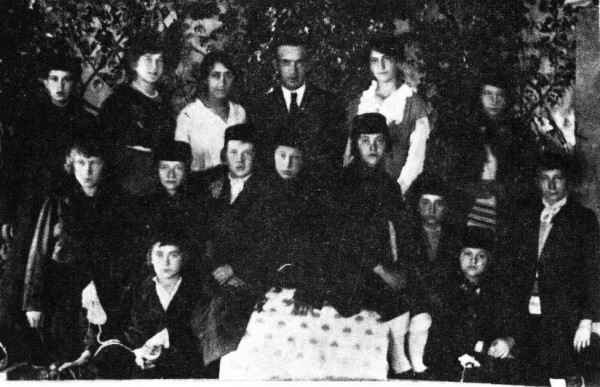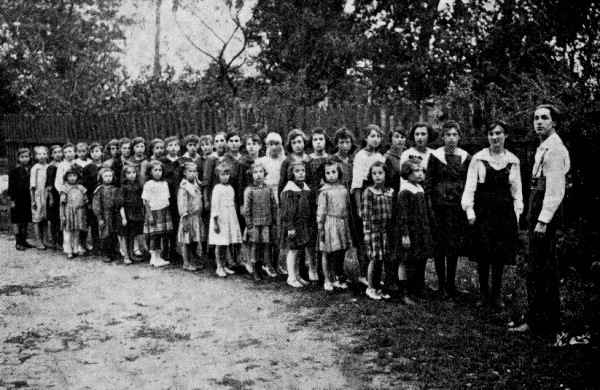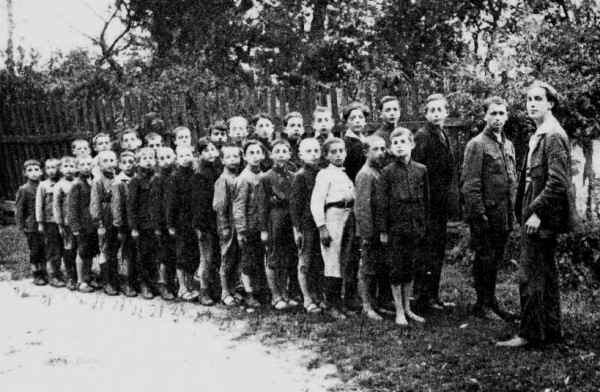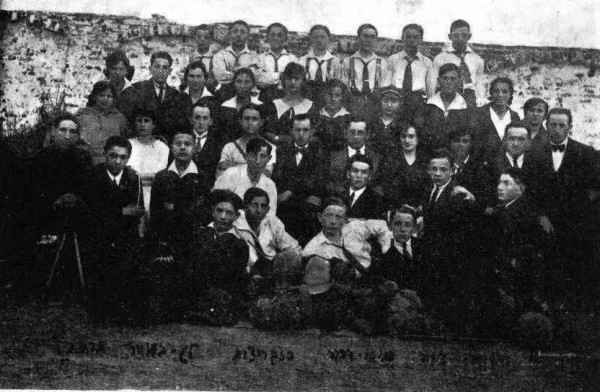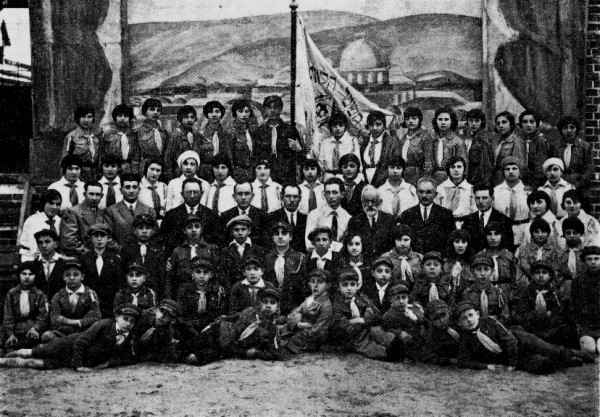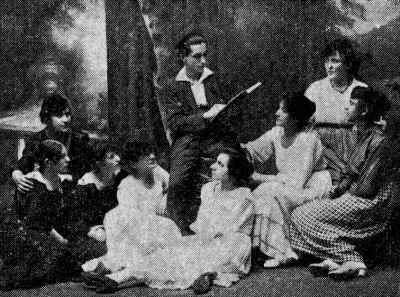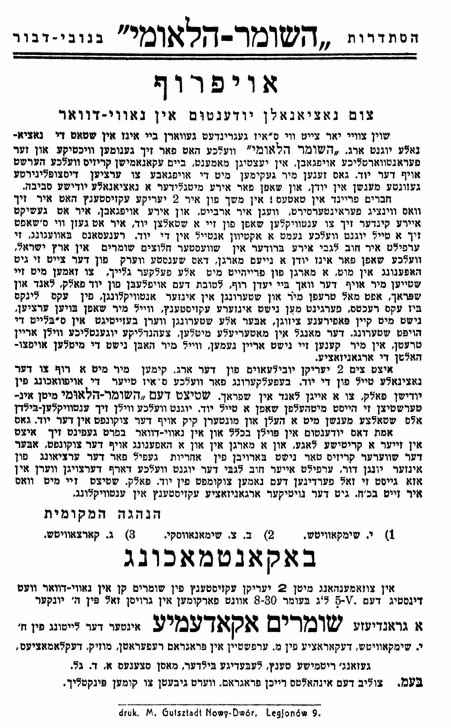[Page 201]
The Zionist Youth Movement
by Yosef Shimkovitsh, Tel Aviv
Translated by Miriam Leberstein
Between two rivers – the Vistula and the Narew – flowed the life of Nowy Dwor and its Jewish population. Similar in appearance to all Polish shtetls, it had two main streets –Warshawer and Zakrotshiner – and tens of small, narrow streets which branched out from them to and around the large market place. This was where Jewish life was concentrated, where people worked and ran businesses, making a living from skilled crafts and commerce. The town came especially alive on market days and even more so during fairs. All the streets around the market place were clogged with peasants' wagons loaded with grain and fruit, and everything got mixed up in one big, noisy commotion of buying and selling, the crowing of cocks, the mooing of cows and the neighing of horses.
Here people grew old, new generations grew up with new desires and hopes and the two quiet rivers flowed by and lent the town so much romantic beauty.
*
The quiet rivers often rose up, overflowing their banks in anger, bringing destruction and death. And so, too, the way of life in the town did not always flow tranquilly. In 1914, everything overflowed the banks; nations and peoples competed in destruction, and our small, well established Jewish town, with its pious, hard–working Jews, found itself smack in the middle of the world's confusion because of the military bases that were located there.
The Jews of Nowy Dwor had to leave their homes and find places to stay in Warsaw and its surroundings, somewhere to lay their heads and find a way to support their families.
|
|
A performance by Pirhei Zion in 1918
Participants, from right to left, first row: Rokhele Shikora, M.Yosefson
Second row: Yosef Shimkovitsh, Bronia Roznshteyn, Ptashek, Baltshe Yosefson, Ester Grosman, Leybl Segal, Nekhe Gershon, Tsirl Hirshbeyn
Organizers, from right to left, in the background: Sonia Zilbertal, her husband, Dovid Lerner, Rivke Yerozalimski, Rokhele Neufeld, Herman Abramovitsh |
[Page 202]
Not until 1915, when the Germans occupied the town, did the Jews who had left return to Nowy Dwor, to their homes and their familiar streets. And Jewish communal life began to show signs of revival; new ideas, new ways sprang up like green shoots, and new social institutions were established.
First, they established a relief committee, consisting of community leaders, headed by Rabbi Neufeld. With the substantial assistance of the American Joint Relief Committee they founded a soup kitchen for the poor under the leadership of Gitl Ptashek.
But “man does not live by bread alone” and there also appeared the beginning of a new movement, under the leadership of activists from Hovevi Zion [Lovers of Zion], headed by the veteran Sh. N. Srebrenik, guided by the ideals of Jewish nationalism. As in all the towns at that time, various political parties and cultural and social organizations formed.
There arose an interest in sports – a healthy mind in a healthy body. This was no accident, since athletic ability could help in a time of emergency. The group Maccabee was formed under the direction of Binyomin Fridman, Berish Mundlak, M. Knaster, and A. Roznshteyn. It should be noted that the occupying German forces were very liberally inclined
[Page 203]
toward the Jews and especially the sports organizations. One of the German soldiers, a Jew named Brand, actively participated in the Jewish sport movement and used the Hebrew language in teaching sports. He prepared the young sportsmen for a tournament in which they were very successful.
The rise of the national–progressive movement tore Jewish young people away from the old–fashioned kheder [religious school for young children] to seek learning and knowledge in the more modern educational institution of the kheder metukan [modern, reformed kheder]. Thanks to the same impulse, the Zionist youth movement began. At the initiative of Sh. Kartsovitsh, Y.Magid, M. Roznshteyn and A. Srebrenik the first youth organization was formed, located in Bialamien's house, where they held readings and discussions, dealt with new problems and sought new solutions.
With the news of the Balfour Declaration and of the fall of the Tsarist regime, new hopes arose among the Jews, and the youth movement Pirhei Zion [Flowers of Zion] was founded. The first work Pirhei Zion took on was social welfare. The World War had left behind many widows and orphans among the Jews of Nowy Dwor. Help was urgently needed, and the young people of Pirhei Zion distinguished themselves in this area. On the initiative of Dovid Lerner, Rokhl Neufeld, R. Yerazalimski, and Kh. Roznshteyn the young people conducted a fund–raising campaign to help the needy. The members of Pirhei Zion were N. Gerson, B. Roznshteyn, Y. Shikoro, Ts. HIrshbeyn, B. Yosefson, Y. Yosefson, Leybl Segal, B. Ptashek and myself.
We created a drama circle which put on various performances with song and dance, providing much needed entertainment, as well as raising money for the relief committee. Thanks to the energetic efforts of the women Pirhei Zion members – Froy Turkltaub, Mindl Knaster, Froy Kshetshanovska, Sh. Levit, Kupietz, Rokhele Neufeld, R. Yerozalimski, and the Sashinski sisters – and the teacher, Yosef Roznsaft (later educational leader of the movement), we waged a campaign to establish our own quarters, to which the Jewish population responded very warmly.
Roznboym's premises were turned over to the leadership: Khaim Vermus, A. Gorber, Leybl Segal, Mendl Srebrenik, Landau, Guretski, and Y. Shimkovitsh. Only when they got their own place, did they begin to function at full speed.
The high point of the movement came with the announcement of the Balfour Declaration. The town rejoiced, enthusiasm drove the Jewish masses into the street, dressed in their holiday best, feeling that they would soon be delivered. Crowds gathered in the big synagogue, full of joy, singing nationalistic songs, and Rabbi Neufeld spoke of the events of the day. In Roznboym's hall, too, there was a meeting where Reb Shimshen Note Srebrenik and Yosef Roznzaft spoke.
After years of pain and suffering, sacrificed on the altars of strangers, longing for their own place, the Jewish population awoke and the movement took wing. Man and women brought their valuables –watches, gold rings and earrings, and everyone felt ready to do something great.
Pirhei Zion carried out a varied program, spreading the word about national liberation among school students and other groups. Thanks to them, young people started to sing Hebrew songs in the streets of the town. At that same time, fund raising efforts on behalf of the Jewish National Fund grew, and young people
[Page 204]
|
|
| Groups of Hashomer Hatsair with their educational leader, the teacher Yosef Roznzaft |
[Page 205]
competed to raise money.
I remember many events and names of the activists: Gotlib, Baranek, Shikora, Yehiel Holtsman, Segalovitsh, the Zaltsman brothers –former members of the religious youth group Hatevuna [Wisdom] founded by Elimelekh Neufeld during the German occupation. Some of them also belonged to the former Agudath Yesherun, whose leader was the social activist from Eretz Yisroel, Ben Tuvim, and which changed its name after the war to Tiferes Bokhurim [Splendor of Youth]. They were the pioneers of a national–religious movement under the leadership of Rabbi Elimelekh Neufeld.
The scout organization Hashom Hatsair had a special place in the Zionist movement in the years 1919–25. In actuality it was the continuation of Pirhei Zion. Under the leadership of teacher Yosef Roznzaft (died in Tel Aviv) boys and girls aged 8 and over were divided into groups and created the core of the organization. The work of Hashomer Hatsair was structured on strong discipline and strict rules. It was forbidden to smoke, or to stroll in the streets after 9 P.M. The young people often shared their educational instruction with their parents, and had a big influence on the town's Jewish population.
The youth of Hashomer Hatsair made excursions to nearby towns – Pomiekhova, Zakrotshin, Jablanna, et. al. Their dramatic circle put on plays in Junker's hall, like “The Selling of Joseph” and “The Guard” (a portrayal of life in Eretz Yisroel) and also various sports events run by the older members. If, in those days, you heard the sounds of singing and dancing, it meant you were close to the Hashomer Hatsair headquarters, where
|
|
| Nowy Dwor Hashomer Hatsair on an excursion in Zakrotshin |
[Page 206]
they were forging a new soul for Jewish youth.
And from theory, came action – the era of aliya [emigration] to Eretz Yisroel began in Nowy Dwor. Making aliyah were Lipe Mundlak (1922); Avigdor Korn (1924); Mendl Srebrenik and Yosef Shimkovitsh (1925); Yitshak Griner, Khaim Kohn, and M. Kokhalski (1926). The worsening of conditions for Polish Jewry stimulated further aliyahs. Anti–Semitism grew; the taxation policy of the so–called Grabski system was aimed exclusively at the Jews to destroy them economically. All of this resulted in the departure of the most active young people for Eretz Yisroel, also causing a weakening of the Zionist movement. All of these strictures began to be felt in 1926–29.
Still, a new organization was established – Hertzeliyah – initiated by B. Ts. Shimanovski, Adela Papier, the Tsaytag sisters, Sore Sashinski, Hinde Tokolska. In addition to basic Zionist activity like fundraising, they also participated in local communal life; they were active in the elections to the city council and the kehile [organized Jewish community]; and also did educational work and attended Zionist conferences and congresses.
Other organizations with various Jewish orientations were founded like Betar, Poalei Zion, Mizrachi and Agudath Israel.
Between 1929 and 1933, when we heard the news about the events in Eretz Yisroel, the apathetic state of the movement was shattered; the solidarity with the settlement in Eretz Yisroel revived national consciousness and gave new strength to the weakened movement. At this time, the organization Hashomer Haleumi [National Guard] was founded, which ran multi–faceted
|
|
| Hashomer Haleumi with the organization's patrons: Shabsti Shtoltsman, Fishl Fridman,
Shimshen Note Srebrenik, Yosef Shimkovitsh (leader), Tuvia Frid, Yitshak Griner, Note Koyfman, Gershon Kartsovitsh, BenTsion Shimanovski |
[Page 207]
programs in every area. All of the active elements of nationalistic Jewish youth joined. There, they learned Hebrew, Bible and Jewish history, and national consciousness grew stronger. A fund for the establishment of a Tarbut [Hebrew–language] school was established, thanks to the enthusiastic participation of the members of Hashomer Haleumi and of the Zionist activists Sh. N. Srebrenik, Koyfman, Fridman, Y. Griner, G. Kartsovitsh, Rokhl Neufeld. On Lag b'Omer 1930 the Tarbut school opened in Junker's building.
The visit to Nowy Dwor of the sejm [Polish legislature] deputy and Zionist leader Yitshak Grinboym was a great event. The entire Jewish community received the proud fighter for Jewish interests with honor and enthusiasm. Masses of Jews rushed to see and greet the guest. The welcoming ceremony was packed. At their festive reception, the prominent Jewish activists and representatives of all the parties and institutions gave their blessings. The Polish mayor of Nowy Dwor brought greetings. And opposing political groups like the Bund and Agudath felt like partners in this great holiday in honor of Yitshak Grinberg, the courageous defender of Jewish interest.
*
From 1933 to 1963, 30 years have passed. Until 1939, our brothers and sisters, comrades and friends, the Jews of Now Dwor, hoped and yearned, lived and dreamed, near the two quiet rivers – the Vistula and the Narew. The rivers kept flowing, sometimes quietly, sometimes stormily but after 1939, the Jews of Nowy Dwor….
|
|
| The teacher Yosef Roznzaft reading a play for the dramatic section of the Zionist organization
From right to left: Sore Altshteyn, Holtsman, Zelde Mundlak, Soretshe Srebrenik, Yentl Mundlak, Khane Tsaytag, Sore Knaster, Beyle Semyatitski–Finklshteyn |
[Page 208]
|
|
| Appeal by Hashomer Haleumi to the Jews of Nowy Dwor |
This material is made available by JewishGen, Inc.
and the Yizkor Book Project for the purpose of
fulfilling our
mission of disseminating information about the Holocaust and
destroyed Jewish communities.
This material may not be copied,
sold or bartered without JewishGen, Inc.'s permission. Rights may be
reserved by the copyright holder.
JewishGen, Inc. makes no representations regarding the accuracy of
the translation. The reader may wish to refer to the original material
for verification.
JewishGen is not responsible for inaccuracies or omissions in the original work and cannot rewrite or edit the text to correct inaccuracies and/or omissions.
Our mission is to produce a translation of the original work and we cannot verify the accuracy of statements or alter facts cited.
 Nowy Dwór Mazowiecki, Poland
Nowy Dwór Mazowiecki, Poland
 Yizkor Book Project
Yizkor Book Project
 JewishGen Home Page
JewishGen Home Page
Yizkor Book Director, Lance Ackerfeld
This web page created by Jason Hallgarten
Copyright © 1999-2026 by JewishGen, Inc.
Updated 10 Feb 2015 by JH
